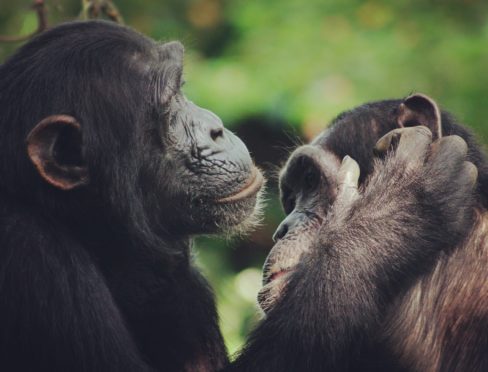
Fife research of chimpanzees helping to trace the evolution of human speech
Scientists say they have uncovered new evidence of how human language originated by studying the lip-smacking gestures of chimpanzees.
by Neil HendersonResearchers from St Andrew’s and Warwick universities have found the rhythms have a similar pattern to human speech.
It follows previous research on monkeys which showed their lip-smacks have a rhythm of about five cycles per second (5Hz) – much like every human spoken language.
However, until now there was no evidence from African apes, such as gorillas, bonobos and chimpanzees – which are related more closely to humans.
The group investigated the rhythm of chimpanzee lip-smacks, produced by individuals while they groomed one another, and found an average speech-like rhythm of 4.15Hz.
The researchers used data across two captive and two wild populations, video recordings collected at Edinburgh Zoo and Leipzig Zoo, and recordings of wild communities including the Kanyawara and the Waibira community, both in Uganda.
Dr Cat Hobaiter, from the School of Psychology and Neuroscience at the University of St Andrews, said: “We have so many spoken languages, but they all have a common rhythm. Fascinatingly, this same rhythm seems to run through our primate family tree.
“There was evidence of it in some of the monkeys but they are really distantly related to us. In being able to say this is also true of our closest relatives, we finally manage to close that big gap in the literature that couldn’t draw the evolutionary line between all of the other primates and human beings.
“Human spoken language is so different to anything we find in the rest of the animal kingdom, but we have so many other ways of communicating information, such as body language and facial expressions, that are similar to animal communication,” she added.
“This type of signal in the primates, the monkeys and chimpanzees, has something in common with language and maybe that is one of the foundation stones on which we started to build.”
Dr Adriano Lameira, from the Department of Psychology at the University of Warwick said the results proved spoken language was pulled together using “ingredients” that were already available and in use by other primates.
“We found pronounced differences in rhythm between chimpanzee populations, suggesting that these are not the automatic and stereotypical signals so often attributed to our ape cousins,” said Dr Lameira.
“Instead, just like in humans, we should start seriously considering that individual differences, social conventions and environmental factors may play a role in how chimpanzees engage ‘in conversation’ with one another.”

Help support quality local journalism … become a digital subscriber to The Courier
For as little as £5.99 a month you can access all of our content, including Premium articles.